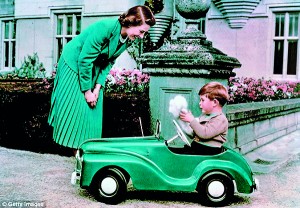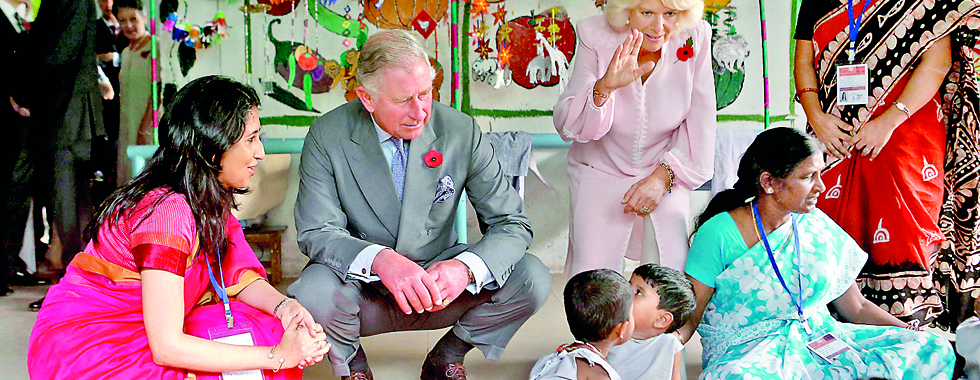Sunday Times 2
Charles as child
Prince Charles — ‘rosy, plump, healthy and bawling’ and ‘with a fair fluff of hair’, according to a courtier — was born at 9.14pm on 14 November, 1948, 65 years ago next Thursday.
A crowd of 3,000 huddled outside Buckingham Palace and cheered when the birth announcement was posted on the railings after a 30-hour labour, although an excited policeman had already tipped off those at the front.
The birth of the 7lb 6oz future king, second in line to the throne and the first grandchild for George VI and Queen Elizabeth, came almost a year after the princess’s marriage to Lieutenant Philip Mountbatten. Marion Crawford, governess to Elizabeth and Margaret, recalled Elizabeth revealing her pregnancy by whispering shyly, ‘I think we’ll get out my old pram, Crawfie.’
The country rejoiced at the birth. Fountains splashed blue in Trafalgar Square, there was a 41-gun salute in Hyde Park, the bells of St Paul’s Cathedral and Westminster Abbey pealed, the Poet Laureate burst into verse, bonfires were lit — and 4,000 congratulatory telegrams flooded in.
The delighted king and queen gave Elizabeth a diamond, ruby and sapphire brooch shaped like a basket of flowers, which she was to wear 65 years later at her great-grandson Prince George’s christening last month.
There were several cakes at Charles’s christening, the principal being elaborately decorated and topped with a baby in a silver cradle, while another featured a silver carousel designed and made by wounded ex-servicemen.
Elizabeth breastfed Charles for two months but gave up after catching measles. He was sent away briefly — the first of many separations. Charles has spoken of his sadness that as a serving naval officer his father missed his first three birthdays, was absent for nearly a year when he was two, then missed several others.
Philip, though a hands-on father who instigated hide-and-seek games and model-making sessions, believed in tough love. ‘I want Charles to be a man’s man,’ he said – and bought him a cricket bat before his first birthday. The Queen, however, was more remote because of her royal duties, and although both parents tried to be there for bath and bed time, the little boy saw

28th September 1952: Princess Elizabeth watching her son Prince Charles playing in his toy car while at Balmoral
his mother only at intervals.
Nevertheless he was cocooned with love by grandparents – after the king died in 1952, he developed an exceptional bond with the Queen Mother — by his nanny Mabel Anderson, Lady Susan Hussey, who was lady-in-waiting to the Queen, and Martin Charteris, her private secretary. Much later he became very close to his great-uncle Lord Mountbatten.
Charles’s grandparents read him favourite books including The Tales of Beatrix Potter, which had been given to his grandmother, aged four, in 1904 and The Childhood of Jesus. He loved a wooden trolley with bricks – the Prince Charles Express – and his green Sunbeam Coupe pedal car.
Anne was two years younger than Charles, born in August, 1950. They would be pushed side by side in their prams, the extrovert Anne in jacket and bonnet, the quieter, introvert Charles in a coat with Peter Pan collar piped in white and two rows of pearl buttons – which Diana later copied for Wills and Harry. Anne could be mischievous — once she let Charles’s rabbit Harvey out of his hutch and stood laughing, with her hands on her hips, as the gardeners raced around trying to catch him.
Holidays at Balmoral, Sandringham and Windsor were made up of exhilarating rounds of shooting, stalking, fishing and riding. Charles also learned to ice skate. Philip taught him to swim, sail, ski and play polo and, being a talented artist himself, to paint.
He believed that if a youngster could excel at even one thing the confidence engendered would spill over into other facets of his or her life. He was relieved that Charles adored the outdoors, and was a good shot — at eight accompanying the beaters and at ten dispatching his first grouse. It would stimulate Charles’s love of the countryside, and his interest in conservation and the environment.
As a child Charles was sensitive and his outward reserve concealed a painful insecurity. He’s admitted he often felt humiliated by his father’s gruff and impatient manner, while some felt that Charles was scared of him. Nevertheless, when small he hero-worshipped Philip, copying the way he walked with hands behind his back. His relationship with the Queen was more formal – once at Balmoral, Charles asked his great-aunt Princess Mary to get down the sweetie jar but when they heard the Queen coming Mary quickly put the jar back and Charles ‘froze with fear’.
Nannies also play a huge part in a royal’s upbringing, and Charles was unaware most families did not have them. Visiting a Welsh mining village he chatted to two children then observed politely of the woman next to them, ‘Is this your nanny?’ And once, he asked, ‘Mummy, what are schoolboys?’
At five he began lessons with governess Catherine Peebles and at eight became the first heir apparent to attend an outside school, Hill House in London’s Knightsbridge.
Often absent with colds and tonsillitis, Charles eventually had his tonsils removed and was given them in a jar of preservative. He took them everywhere but once left them on the pulpit of a small chapel between the Grand Corridor and St George’s Hall at Windsor Castle – where he’d go alone to give imaginary sermons.

Britain's Prince Charles (2nd L) and his wife Camilla, Duchess of Cornwall, interact with children inside a room at a Mobile Creche in Mumbai yesterday. Prince Charles and his wife Camilla, Duchess of Cornwall, are on a nine-day visit to India. REUTERS/Danish Siddiqui
Less than a year after joining Hill House he was boarding at Cheam, the prep school in Berkshire where he became head boy. He wrote to the Queen Mother telling her of cricket matches, of a letter from ‘Mummy and Papa’ in Canada and a thunderstorm and always signing off, ‘With lots and lots of love from your very loving grandson Charles’.
He kept the same geometry set throughout and marked his ruler P Charles. He loved history lessons but struggled to make friends. One member of the Household says he ‘loathed’ Cheam. And one day, aged nine, he cringed when watching the TV news with classmates as the Queen announced — without first telling him — she’d made him Prince of Wales.
Tough Gordonstoun in Scotland, where he spent five years from the age of 13, was a bigger shock. Mocked for his prominent ears and stunned by the ‘sheer nastiness’ he encountered, he described his time there as ‘a prison sentence’ and ‘pure hell’. His letters home ached with misery. ‘I simply dread going to bed as I get hit all night long,’ he wrote.
But he was frightened of complaining, even when his exercise book containing his thoughts on democracy and the monarchy was stolen and when bullies targeted him in rugby matches. His parents knew what he was going through, but wanted his education to prepare him to be king.
As if by way of compensation, they indulged him in the holidays. When Philip bought a 100mph Alvis convertible at the then astronomical price of £3,100, he took 14-year-old Charles and the Queen for a spin — with the Queen’s favourite corgi on her lap.
At Gordonstoun Charles found solace in the art room, where the master encouraged him, and he made a pottery mug for Mabel Anderson. He was enthralled by the art in royal residences. ‘I used to wander around Windsor Castle after the public had gone,’ he said.
‘I had a marvellous time exploring the State Apartments and looking at the paintings.’ Of a Landseer he noted, ‘A dazzling image depicting Prince Albert’s beloved greyhound Eos hangs at Balmoral, where it greets us on our way to and from the dining room and is a cheerful reminder that our family’s always had a tremendous love of dogs.’
By the time Charles was a senior at Gordonstoun he had made some friends and was more confident. At 17, he was an exchange student for six months at Timbertop, 100 miles from Melbourne, Australia, where the emphasis was on self-reliance. His parents felt it was another way of toughening him up and that it was time to make his first contact with the Commonwealth.
The boys called him ‘Bloody Pom’ but were friendly. They shared chores like mucking out pigs and felling trees and went on three-day 70-mile hikes in intense heat. The visit was hugely successful, an immense boost to Charles’s self-esteem. ‘I absolutely loved it – the most wonderful experience,’ he said. Observed an aide, ‘He went there a boy and came back a man.’
When he returned to Gordonstoun he was made guardian (head boy), like his father. Academically average, he nevertheless achieved A-levels in history and French and in one history paper he was among the top 6 per cent of 4,000 candidates. There was only one scandal.
At 14, accompanied by his detective, he had been spotted enjoying a cherry brandy in a bar where they’d fled to escape attention. ‘I thought only alcohol could be served in a bar,’ explained Charles, ‘so when the barman asked me what I wanted to drink I said cherry brandy – it’s what we drink out shooting.’
Charles went up to Trinity College, Cambridge – chauffered in a red Mini on his first day – to read archaeology, anthropology and history, eventually being awarded a BA followed by an MA. He enjoyed the musical and theatrical life, in one revue poking fun at himself by sporting an umbrella while commenting, ‘I’ve led a sheltered life’ and in another, arm-in-arm with a pretty girl he said, ‘I like to give myself heirs.’
He spent a term at the University of Aberystwyth learning Welsh history and language in preparation for his Investiture, aged 20, by the Queen at Caernarvon Castle on 1 July, 1969. One privilege at the Welsh university was having a personal laundry service — a relief, no doubt, after a pair of his underpants, spirited away from the communal student laundry at Cambridge, had been put on display in an Australian shop window.
Another privilege was accorded to him when, at 19, he flew with Prime Minister Harold Wilson and Opposition leader Edward Heath to Australia for a memorial service. Wilson and Charles were given their own beds on the aircraft but Heath, whom they outranked, had to spend the 32-hour journey strapped in a standard seat.
Charles took flying lessons of his own with the RAF before leaving Cambridge, went on to train at Cranwell and qualified as a jet and helicopter pilot. Then came five years in the Navy, eventually commanding the coastal mine-hunter HMS Bronington, where he had to keep a bucket on the bridge because of seasickness.
In 1976 he started the Prince’s Trust, which has helped to change more than 750,000 young lives. He is also occupied with the Duchy of Cornwall, his private estate which funds his public, charitable and private activities and those of his family.
Charles is said still to be sensitive but his youthful knocks have led to resilience, strength of character, compassion and a strong sense of duty. Happily married to Camilla, he has two splendid sons from his marriage to Diana.
And now, as a grandfather, he can involve himself in the life of another future king. But he will never lose his determination to help the disadvantaged — which doubtless stems from his years of being bullied and feeling isolated.
‘I have had this extraordinary feeling for years of wanting to heal and make things better,’ he says. ‘I feel it’s my duty to worry about people’s lives and try and find a way to help.’
(c) Daily Mail, London


